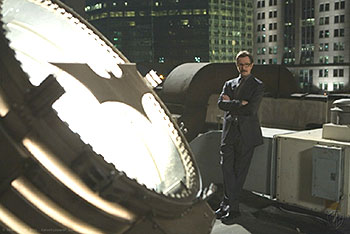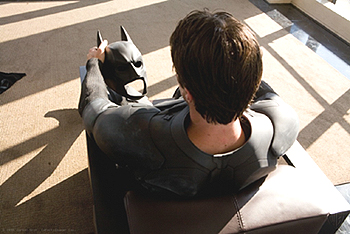The Abyss Gazes Into Thee: Batman, The Dark Knight, and Modern Gothic
Published on September 29th, 2008 in: Books, Comics, Halloween, Horror, Issues, Movies |Fear can be both a liberating and a constricting force, and it is this dynamic which directs the initial creation and development of the Batman character. In Batman Begins, Bruce Wayne is confronted by his darkest urges when he seeks vengeance against his parents’ killer. Crime boss Carmine Falcone tells him, “You always fear what you don’t understand.” This is the impetus for him to escape his life and turn into a quasi-criminal.

He is plucked from the underworld by Henri Ducard, who tells him, “to manipulate the fear in others you must first master your own” and more significantly, “to conquer fear, you must become fear.” Ducard shows Bruce how to do this with a hallucinogenic powder derived from a rare blue flower. This psychological journey is exploited further when, under Ducard’s orders, Dr. Jonathan Crane releases a weaponized version into the water supply of Gotham and sardonically comments, “The only thing to fear is fear itself.”
In order to vanquish the criminals responsible for killing his parents and transforming Gotham into a cesspool of despair, Bruce decides to become something else, a bat, a creature which is his own greatest fear. He tells Alfred:
“People need dramatic examples to shake them out of apathy, and I can’t do that as Bruce Wayne. As a man, I’m flesh and blood. I can be ignored, I can be destroyed. But as a symbol. . . as a symbol, I can be incorruptible. I can be everlasting.”
The idea of the double appears frequently in psychology. In Sigmund Freud’s essay “The Uncanny,” he discusses the work of author Otto Rank, and notes that “the ‘double’ was originally an insurance against the destruction of the ego,” or what Rank called “an energetic denial of the power of death.” (8) Freud argues that “the ‘immortal’ soul was the first ‘double’ of the body.” (9)
Batman becomes Bruce’s double, his way of insuring against the destruction of his own ego. Thus, Batman as Gothic villain-hero is born, and with him a duplicitous relationship that will come to dominate and torment Bruce Wayne’s life.
Such uneasy relationships are one of the hallmarks of Gothic. Punter quotes author Angela Carter who says that Gothic “retains a singular moral function—that of provoking unease.” (10)
Freud also explores this type of unease in his essay, pointing to continuities in the definition of the word “uncanny” across different languages, including the German counterpart “unheimlich”:
“In general we are reminded that the word ‘heimlich’ is not unambiguous, but belongs to two sets of ideas, which, without being contradictory, are yet very different: on the one hand it means what is familiar and agreeable, and on the other, what is concealed and kept out of sight.” (11)
It is Bruce Wayne who presents the face of what is “familiar” and agreeable” while Batman is “concealed” and “kept out of sight.” There is doubt as to which is the “real” Bruce. Rachel Dawes points out at the end of Batman Begins that Bruce’s “real face is the one that criminals now fear” and that “the man who vanished. . . he never came back at all.”

Freud addresses this uncertainty when discussing the uncanny in Gothic author E. T. A. Hoffman’s novel, The Devil’s Elixir, noting that the existence of the double is “. . . marked by the fact that the subject identifies himself with someone else, so that he is in doubt as to which his self is, or substitutes the extraneous self for his own. In other words, there is a doubling, dividing and interchanging of the self.” (12)
However, it not just Bruce Wayne/Batman who represents this duality; in Batman Begins there are plenty of doubles to go around, notably Ra’s Al-Ghul/Henri Ducard and Dr. Crane/Scarecrow. This motif continues in The Dark Knight, whose characters recall the duality of such well-known Gothic conceptions as Frankenstein and Dr. Jekyll.
Time limit is exhausted. Please reload the CAPTCHA.